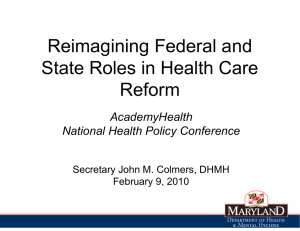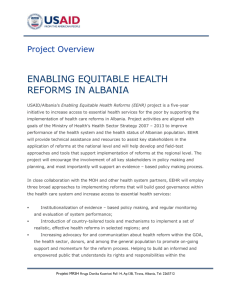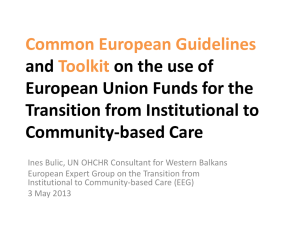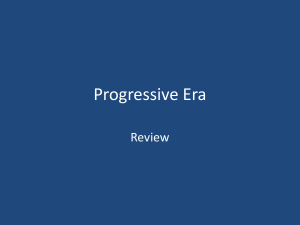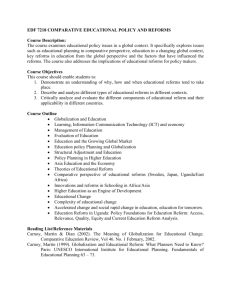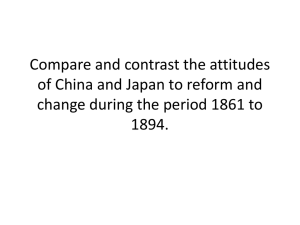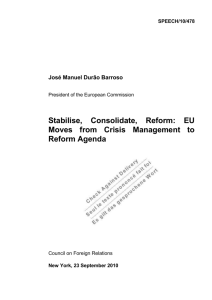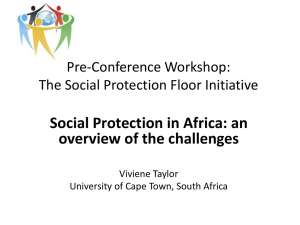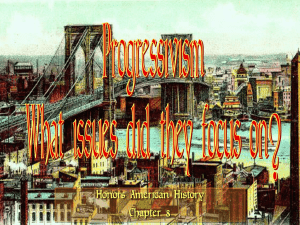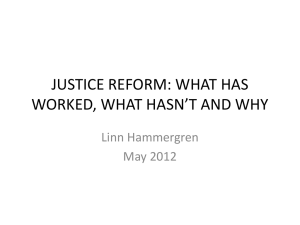Bulgaria in action
advertisement
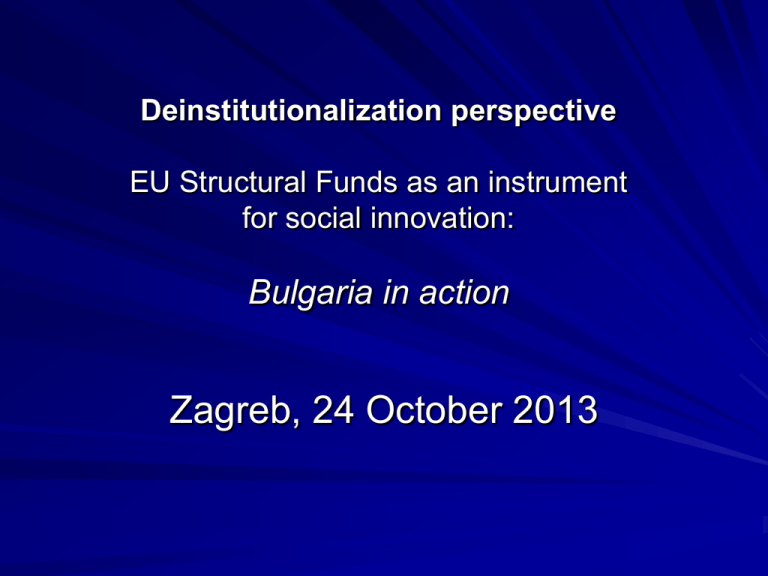
Deinstitutionalization perspective EU Structural Funds as an instrument for social innovation: Bulgaria in action Zagreb, 24 October 2013 The presentation will include: How the reform has started Who was involved First steps Main outcomes and challenges Lessons learned The context (2009): Institutions for children are a part of the difficult heritage INSUFFICIENT NUMBER OF SERVICES FOR CHILDREN AND FAMILIES ON THE TERRITORY OF THE COUNTRY. INSUFFICIENT FAMILY FINANCIAL RESOURCES, WHICH OFTEN LEADS TO SOCIAL EXCLUSION OF THE FAMILIES AND PLACEMENT OF CHILDREN IN INSTITUTION. LACK OF DEVELOPED SYSTEM OF COMMUNITY-BASED ALTERNATIVES TO INSTITUTIONAL CARE. OVERWHELMING MEDICAL MODEL TO THE CHILD DISABILITY ACCORDING TO WHICH THE INSTITUTION OFFERS THE BEST CARE FOR CHILDREN CHANGED MODELS OF FAMILY BEHAVIOR WHICH LEAD TO OUT OF WEDLOCK BIRTHS AND SINGLE PARENTS. Unsolved during the past years problems that led to “reforms” and “restructuring”, which are often understood as a building refurbishment and do not lead to a significant change UNSIFICIENT COORDINATION BETWEEN THE RESPONSIBLE STATE INSTITUTIONS. Stakeholders involvement: 10 years experience EC support Political will for reforms CSOs agenda - both international and Bulgarian BANSKO 2009 The beginning of the reform - NATIONAL STRATEGY: “VISION FOR DEINSTITUTIONALISATION OF CHILDREN “The DI is a process of replacement of the institutional childcare with community-based family or close to family environment care, which is not limited only to taking children out of institutions. This is a process of preventing placements of children in institutions, creation of new opportunities for children and families to receive support in the community and is done on many levels” ALL PROGRAMMES AND PROJECTS AIMED AT DI AND PROVISION OF CHILD AND FAMILY SERVICES FINANCED BY THE EC AND/OR THE NATIONAL BUDGET ARE REGULATED BY THIS POLITICAL DOCUMENT. The National Strategy: THE MAIN OBJECTIVE OF THE DOCUMENT IS TO GUARANTEE THE RIGHT OF CHILDREN TO FAMILY ENVIRONMENT AND ACCESS TO QUALITY CARE AND SERVICES ACCORDING TO THEIR INDIVIDUAL NEEDS. SPECIFIC OBJECTIVES: 1) LEGAL REGULATION, PROVISION OF FINANCIAL AND HUMAN RESOURCES FOR A WIDE RANGE OF COMMUNITY BASED CHILD AND FAMILY SERVICES TAKING INTO CONSIDERATION THE GOOD PRACTICES AND APPLYING INNOVATIVE APPROACHES; 2) RAISING THE CAPACITY OF THE CHILD PROTECTION SYSTEM BY CLARIFICATION AND EFFECTIVE DISTRIBUTION OF THE RIGHTS AND RESPONSIBILITIES OF THE CHILD PROTECTION BODIES, SERVICE PROVIDERS AND ENSURING AN ADEQUATE PROFESSIONAL CAPACITY FOR THE EFFECTIVE FUNCTIONING OF THE SYSTEM; 3) CLOSURE OF 137 INSTITUTIONS FOR A PERIOD OF 15 YEARS FROM THE ADOPTION OF THIS DOCUMENT; 4) NOT ALLOWING THE PLACEMENT AND RAISING OF CHILDREN FROM 0 TO 3 YEARS IN RESIDENTIAL CARE OF ANY TYPE AFTER THE END OF THE REFORM. Action plan - 2010 Complicated operational document (50 p.) The Action Plan consists of two parts: Part One: specific steps for the implementation of several deinstitutionalisation projects covering the Homes for Medical and Social Care for Children (HMSCC), the Homes for Children with Disabilities (HCMR, HCPD) and the Homes for Children Deprived of Parental Care (HCDPC), and the Project for the Development of Foster Care and Project for the Career Development of Social Workers Part Two: specific measures and activities, aimed at integrated complex policy for children and families and amendments in the sectoral policies. Action plan - 2010 The objectives of the Action Plan in the implementation of the Policy Document are: 1. To develop a system of family-based and community-based services across the country, which shall exclude the necessity of the existence of specialised child-care institutions; 2. To close down in a systematic way all classical-type boarding childcare institutions in Bulgaria thus ensuring the provision of long-term or short-term placement in a family-type care for every child; 3. To develop the legal and regulatory framework necessary for the support of the transition towards the community-based and familybased care; 4. To improve the effectiveness of the care system for vulnerable children and their families. The Instruments: ESF, through OP Human Resources Development - funding for a wide range of social services for children and families at risk; ERDF, through OP Regional Development - targeted support via two grant schemes („Support for renovation and modernization of state healthcare and medical institutions in urban agglomerations” and “Support for deinstitusionalization of social institutions providing care for children in risk" Rural Development Programme - Measure 321 “Main services for the population and the economy in the rural area”; Financing from the state budget for all specialized institutions mentioned in the documents and social services recognized as delegated state activity, introducing the principle “money follow the child”. Other Donors – UNICEF, Lumus Foundation, OAK Foundation. First projects: Project targeting 24 Children with Disabilities “Childhood for all” - 2010 Project for 8 baby institutions (out of 32) - 2011 Project for foster care - 2011 Project for reforming SAA - 2011 Regional planning project – 2011 Capacity building project - 2012 The “unique” EU funding model – crosscutting between ERDF, ESF, RDF Management of the process: High level inter-ministerial working group, managed by the minister of the EU funds, special raptor - SACP Cross-sectoral management of the first projects Expert group for coordination – (ad hoc) Regional development unites – the most important regional authorities Targets: Projects aims: Development of services which shall provide care in family and close to family environment for 7 150(by 31.12.2010) children and young people. Development of services which shall prevent placement in specialised institutions of about 2 000 children each year. 100 000 000 euros for 4 years! New 3000 working places for the first 4 years! Legal frameworks amendments – child rights act, social inclusion act, juvenile justice reform. Main challenges: Securing of good, effective and coordinated management of projects and decision-making in order to provide the most adequate decisions. European operational programs inflexibility!. The main part of the reforms is related with changing stereotypes. Significant risk is reproduction of old models in new services. The forcing of the reforms due to strong public feelings, the pressure for quick actions, the striving to show progress in front of influential outside factors etc. also represents risk. Legal reforms – systems, quality, prevention mechanisms, etc. Political changes. Lessons learned: More investments in the people – decisionmakers and experts in the state institutions Ensuring maximum flexibility More investments in evidance-based analyses and researches More investments in the coordination Starting with legal changes!? Better data collection. More important: It is about leaders and commitment. Don’t underestimate the coordination – between funding instruments, policies, etc. Involve everybody NB: it is impossible everyone to be happy, it is important the children interest to be the leading one. For Bulgaria now the issue is not “shall we do it” but “how we do it”. First steps – next steps. From such reform benefits not only the children in the institutions – focus on prevention and enabling legal framework. CSOs coalition – “Childhood 2025” Thank you for your attention! www.bcnl.org www.equalrights.bcnl.org www.ngobg.info

